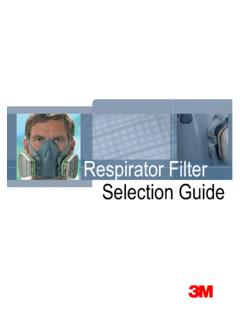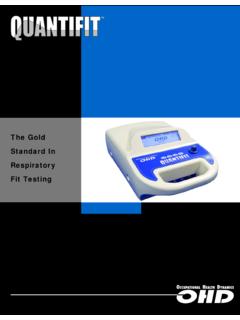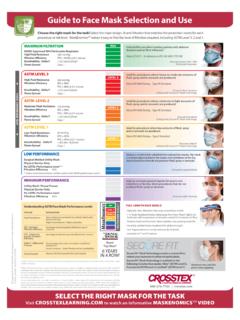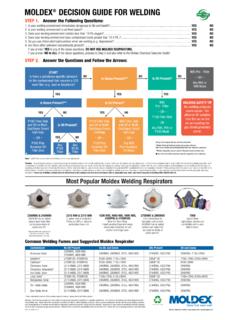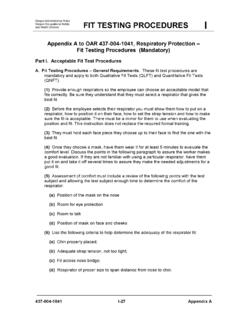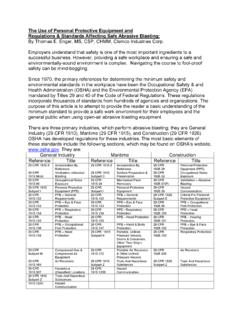Transcription of Administrator's Guide - Centers for Disease Control and ...
1 IiiTBTBR espiratory Protection ProgramRespiratory Protection ProgramIn Health Care FacilitiesIn Health Care FacilitiesAdministrator's GuideAdministrator's DEPARTMENT OF HEALTH AND HUMAN SERVICESP ublic Health ServiceCenters for Disease Control and PreventionNational Institute for Occupational Safety and HealthSeptember 1999ivDDiisclasclaiimermerMention of any company name or product does not constituteendorsement by the National Institute for Occupational Safety and of this and other NIOSH documents are available fromNational Institute for Occupational Safety and HealthPublications Dissemination4676 Columbia ParkwayCincinnati, OH 45226-19981-800-35-NIOSH (1-800-356-4674)Fax number: (513) 533-8573To receive other information aboutoccupational safety and health problems, call1-800-35-NIOSH (1-800-356-4674), orvisit the NIOSH Web site (NIOSH) Publication No. 99-143vFFoorreewwoordrdThe use of respirators in the health care setting is a relatively new but im-portant step forward in the efforts to prevent the transmission oftuberculosis (TB).
2 Air purifying respirators provide a barrier to preventhealth care workers from inhaling Mycobacterium tuberculosis. The level ofprotection a respirator provides is determined by the efficiency of the fil-ter material and how well the facepiece fits or seals to the health careworker s face. A number of studies have shown that surgical masks willnot provide adequate protection in filtering out the TB organism. Addition-ally, surgical masks are not respirators and therefore, are not NIOSH certified and do not satisfy OSHA requirements for respiratory proper use of respirators represents a significant improvement in em-ployee protection against TB. NIOSH realizes that the use of respiratorsinvolves a number of new and perhaps confusing practices for the healthcare community. This manual is designed to serve as a practical Guide forthose individuals responsible for initiating and running a TB respiratoryprotection program in health care areas of the hospital may also require the use of respirators but theprogram and respirators used may be different.
3 If such a program exists inyour facility and has an experienced program administrator , it would be ef-fective to administer the TB respirator program under the existing programand use existing facilities for fit-testing, cleaning, maintenance, storage, document is not designed to provide information on ventilation sys-tems, negative pressure isolation rooms, and risk assessment methodologies,which should be included in a total TB prevention program. The TB res-pirator program described in this document does not supplant therespirator protection program necessary for other regulated hazards ( ,formaldehyde or ethylene oxide) that may be found in health care yours,Linda Rosenstock, , of Contentof ContentssDisclaimerForewordAbbreviations AcknowledgmentsIntroductionRespiratory Protection Program Elements For Health Care Workers Exposed To TuberculosisRespiratory Program AdministrationGeneralNIOSH Recommended Steps for Improving the Knowledge and Skills of the Program AdministratorDutiesStep 1 Conduct a TB Risk AssessmentStep 2 Select RespiratorsRespirator Selection for Protection Against TBIntroductionTypes of Respirators for Protection Against TBA.
4 Disposable Particulate RespiratorsB. Replaceable Particulate RespiratorsC. PAPRsD. Positive-Pressure Supplied-Air RespiratorsStep 3 Write Standard Operating ProceduresSample SOPStep 4 Medically Screen All Usersivvixx1122234555778910111218viiStep 5 Provide TrainingRespirator Training ProgramIntroductionWho Should Receive Respirator TrainingWho Should Conduct this TrainingWhat Should the Training IncludeOSHA Training Requirements Under 29 CFR For TrainingEstablish Specific Training ObjectivesMake the Objectives Measurable and ObservableMake the Objectives Known to the TraineeActively Involve the Trainee in the TrainingAllow Time for AdjustmentProvide FeedbackProvide Refresher TrainingTips For Reducing Resistance and Promoting Safety BehaviorsSafety ManagementSupervisory PracticesAdditional Responsibilities of the SupervisorEnvironmental and Organizational SupportsStep 6 User Seal Check, Fit-Test.
5 And Issue RespiratorsRespirator Face Fitting ProceduresFit-Testing ProceduresUser seal checking ProceduresStep 7 Inspect, Clean, Maintain, and Store RespiratorsRoutine Respirator InspectionIntroductionInspection Before and After Each UseInspection During Cleaning19191919191920212121212122222222 23232424262626272828282830viiiCleaning, Repairing, and Storing Respirators Used For Protection Against and and Sanitizing PAPRSR epairStorageSample SOPStep 8 Evaluate the ProgramRespirator Program EvaluationAnnual EvaluationAdditional EvaluationReferencesAppendix A Respiratory Protection for M. tuberculosisAppendix B OSHA Instruction CPL (TB Enforcement)Appendix C Access to Employee Exposure and Medical RecordsAppendix D Names and Addresses of Respirator Manufacturers and DistributorsAppendix E Respiratory Protection ChecklistAppendix F CDC Guidelines (Pages 4-6)Appendix G Memorandum for OSHA Regional AdministratorsAppendix H Appendix A to.
6 Fit Testing Procedure3030303131313131323336363636373 845627682909397ixACGIHA merican Conference of Governmental Industrial HygienistsAFBAcid-fast bacilliAIHAA merican Industrial Hygiene AssociationANSIA merican National Standards InstituteAPFA ssigned Protection FactorATSA merican Thoracic SocietyccCubic centimeter(s)CDCC enters for Disease Control and PreventionCFRCode of Federal RegulationsCNCC ondensation nuclei counterCNPC ontrolled negative pressureDHHSD epartment of Health and Human ServicesFFFit-factorgGram(s)HCWsHealth Care WorkersHEPA filterHigh-efficiency particulate air filterhrHour(s) (es)LLiter(s)L/minLiter(s) per minuteM. tuberculosisMycobacterium tuberculosismgMilligram(s)minMinute(s)ml Milliliter(s)NIOSHN ational Institute for Occupational Safety and HealthOSHAO ccupational Safety and Health AdministrationQLFTQ ualitative fit-testingQNFTQ uantitative fit-testingPAPRP owered air-purifying respiratorPELP ermissible exposure limitPPDP urified protein derivativeRPAR espirator Program AdministratorsecSecond(s)SOPsStandard operating proceduresTBTuberculosisUSPU nited States Pharmacopeia mMicrometerAAbbreviationsbbreviationsxAA cknowledgmentscknowledgmentsThis document was developed by Nancy Bollinger, Jeff Bryant, WalterRuch, Jerry Flesch, Edward Petsonk, Thomas Hodous, Brian Day, TeriPalermo, Michael Colligan, Linda Martin, and Robert review and assistance were provided by Larry Reed, RolandBerry Ann, and Larry Murphy.
7 Kim Clough, Brian Day, and DorothyTan-Wilhelm produced the poster. We thank Anne Hamilton andChris Ellison for editing and Kim Clough for the cover design,photography, and formatting of the photographs courtesy of MSA, Alpha Pro Tech, and thanks the many reviewers who helped in completing thisdocument, particularly the following agencies and their representa-tives:CDC Hospital Infections Program, Elizabeth BolyardCDC Division of TB Elimination, Patricia SimoneCDC National Center for Infections Disease , Walter BondOSHA Demetra Collia and John SteelnackRuby Memorial Hospital Staff1 IIntroductionntroductionWritten Standard Operating Procedures (SOPs)describing the selection and use of respiratorsmust be developed. Information and guidanceneeded for the proper selection, use, and care ofthese devices must be selection must be based on thehazard to which the worker is exposed.
8 Moreprotective respirators may be needed for cer-tain high-risk procedures [CDC 1994, p. 99].The respirator user must be trained in thecorrect use of the respirator as well as itslimitations. This training must include instruc-tions for wearing and adjusting the respiratorand for checking the must be regularly cleaned anddisinfected. Disposable respirators (cannot beused by more than one person) must be dis-carded if they are soiled or physically dam-aged ( , creased or torn). If the replaceablefilter respirator is used by more than oneperson (that is, not assigned to one personpermanently), it must be cleaned and disin-fected after each must be stored in a convenient,clean, sanitary location. They must be stored sothey are protected from dust, harmful chemi-cals, sunlight, moisture, and excessive heat that are used routinely must beinspected during cleaning, and damaged ordeteriorated parts must be surveillance must be maintainedfor work area conditions and the degree ofworker exposure or stress.
9 Any changes fromthe last evaluation must be identified regular inspection and evaluation ( ,yearly) must be conducted to determine thecontinued effectiveness of the determination must be made that a workerRespiratory ProtectionRespiratory ProtectionProgram Elements For HealthProgram Elements For HealthCare Workers Exposed ToCare Workers Exposed ToTuberculosisTuberculosisFrom 1985 to 1992, the incidence of turberculosis (TB)in the general population increased approxi-mately 14 percent, reversing a 30-year downwardtrend. In 1993, 25,313 new cases of TB were reportedin the [CDC 1994]. Associated with this resur-gence were hospital outbreaks of TB, and the emer-gence of multiple-drug-resistant TB. In response tothese public health threats, extensive efforts weretaken across the nation to improve TB-prevention andTB- Control programs. As a result of these measures,since 1992, there has been a consistent decline in thenumber and incidence of TB ( , cases per 100,000population and 19,855 total cases in 1997) and adecline in multiple-drug-resistant TB [CDC 1998b].
10 The public health and the occupational risks of TBthus appear to be once again decreasing, but theyremain very significant.* Code of Federal Regulations. See CFR in references.+ [29 CFR ] was formerly codified at [29 CFR ].Health care workers exposed to patients with infec-tious TB require protection from that Disease . Be-cause the use of engineering controls (such as isola-tion rooms and ventilation) may not completelycontrol the TB hazard, respiratory protection respirators are used, the Occupational Safetyand Health Administration (OSHA) standard forrespiratory protection for M. tuberculosis [29 CFR* ]+ must be followed. OSHA has stated thatit will promulgate a separate standard for TB; butuntil then, the use of respirators for TB exposureswill be enforced under the original respiratoryprotection program prescribed by OSHA in 29 (see Appendix A). This program requiresthe following:2 NIOSH Recommended NIOSH Recommended Steps forSteps forImproving the Knowledge Improving the Knowledge and and SkillsSkillsof the Program Administratorof the Program AdministratorBecome completely familiar with and un-derstand the OSHA respirator understand standards, interpreta-tion letters, and field manuals whichprovide interpretation and inspectionmethods used by OSHA inspectors (seeAppendix B).










